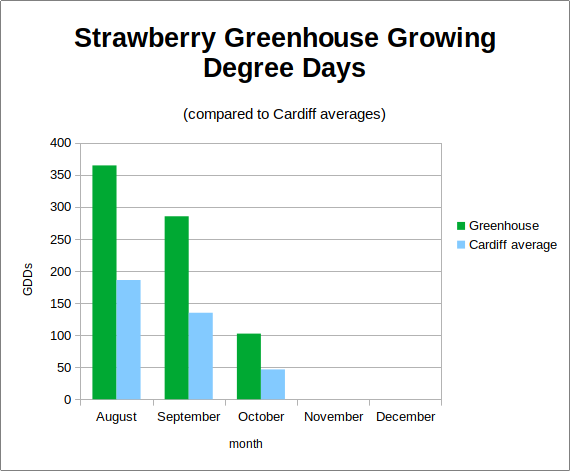
Strawberry plants need light and warmth to flower and produce fruit so in the UK crops are typically only available in the summer. Growing strawberries under glass or in poly-tunnels can extend the cropping season, especially when combined with planting a range of varieties which flower and fruit according to slightly different day-lengths.
The downside of growing strawberries under glass is that temperatures can rise quickly and hot, humid air is perfect for the growth and spread of mildew. For this reason we have developed rapid response temperature and humidity sensors to enable a response to the susceptibility of mildew with an efficient spraying, ventilation and shading regime.
Our strawberry greenhouse trial included the varieties
Centenary (June bearing) and Allure (July bearing and resistant to mildew), plus a Tyneside local variety. These strawberry plants offer potential successive cropping, carrying young leaves, flower buds and fruit at different times in the summer. This is useful because it is expected that the strawberry powdery mildew disease burden will steadily grow during the season until a control measure is applied.

We are using a model developed by AHDB for improved management of disease in strawberry crops .
USING GROWING DEGREE DAYS
One of the valuable things you can do with 24/7 temperature logging in the strawberry greenhouse is to accurately monitor the Growing Degree Days (GDD) in the greenhouse. GDD is the cummulative total of all the days and degrees in the growing year that the temperature Tb is above a base threshold temperature. Tb is typically the temperature at which a plant starts into active growth. Tavg is the daily temperature average , so for each day:
If (Tavg>Tb) then GDD = GDD + (Tavg – Tb)
There has been a lot of research into the relationships between stages of plant growth and GDD values. The University of Georgia College of Agricultural and Environmental Sciences for example, have been studying the effect of GDD variation on the growth of strawberry varieties in Akansas, North Carolina and Virginia.

Here in Cardiff, Wales we typically have fewer growing degree days than the southern United States. For this reason, greenhouse and poly-tunnel cultivation is particularly advantageous. The chart below shows how GDD values were approximately doubled in the Strawberry Greenhouse compared to average GDDs this summer and autumn.

Of course the downside of greenhouse cultivation is the increased risk of mildew and other diseases and pests compared to field-grown fruit. Happily we found that, following the protocol from UH and the AHDB model, prompt ventilation as temperatures rose was able to avert any development of powdery mildew over the course of the season. Whitefly was a minor irritation but removing plant trays from the greenhouse and spraying with dilute detergent/KHCO3 solution was sufficient to control the pest without any other intervention.

Curves like this can be very helpful in explaining strawberry growth. Planning for big healthy plants typically leads to higher yields. Researchers at Purdue University for example found that delaying planting out of strawberry plants by just two weeks led to a 30% decrease in yield, which they attributed to missed growing day opportunities at the end of August.
Find out more about the technology here.